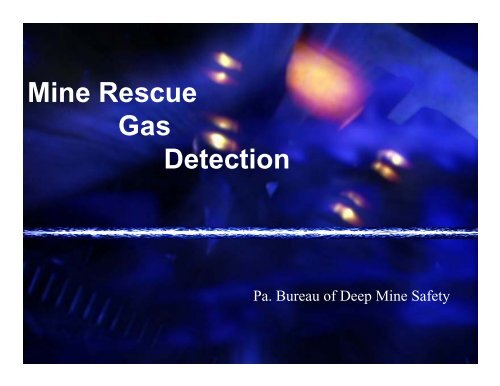Mine Gases - Usmra.com
Mine Gases - Usmra.com
Mine Gases - Usmra.com
- No tags were found...
Create successful ePaper yourself
Turn your PDF publications into a flip-book with our unique Google optimized e-Paper software.
<strong>Mine</strong> RescueGasDetectionPa. Bureau of Deep <strong>Mine</strong> Safety
What do I need to know?• What gases make up fresh air• What are the hazards of mine gases• Specific Gravity of each gas• Origin of mine gases• Explosive range• Exposure limits• What detection device(s) do I use
Category of <strong>Gases</strong>• Noxious – Asphixiant due to alack of oxygen.• Toxic – Poison, either long orshort term exposure.
Physics of <strong>Gases</strong>• Specific Gravity : The <strong>com</strong>binations of gases that makeup air is what other gases are <strong>com</strong>pared with. Air isconsidered to have a specific gravity of 1.0• Temperature: Cold gases will diffuse slowly, hot gaseswill diffuse quickly.• Graham's Law: The rate of diffusion, the lower thespecific gravity, the faster it will diffuse.• Barometric Pressure: The lower the pressure, thefaster a gas will diffuse.• Solubility: The ability to dissolve in water.
Exposure Limits• Threshold Limit Value (TLV)The allowable amount of gasexposure for an 8 hour day for 5days a week without harmfuleffects.• Short Term Exposure Limit(STEL) The allowable amountof gas exposure for 15 minuets.
Measurement of <strong>Gases</strong>Parts Per Million (PPM)- The most accuratemeasurement of a contaminant in theatmosphere.(4)PERCENT PPM1.0 ........................................10,000.1 .....................................… 1,000.01 ...................................… 100.001 ..................................… 10.0001 ................................… 1
<strong>Mine</strong> <strong>Gases</strong> & their ComponentsAIR• Chemical Formula: None• Specific Gravity: 1.000• Source: Atmosphere• Characteristics: No color, odor, or taste• Pure dry air at sea level contains thefollowing:– Oxygen...................... 20.94 %– Nitrogen..............…... 78.09 %– Argon........................ 0.94%– Carbon Dioxide......... 0.03%
Oxygen• Specific Gravity: 1.105– Chemical Formula: O 2– Oxygen will not burn or explode– Source: Atmosphere– Characteristics: No color, odor or taste– Note: When another gas is introduced into theatmosphere of an artificial environment, suchas a mine, tunnel or man holes, oxygen can bedisplaced causing asphyxiation.
Oxygen Present % Effect• 21% Breathing Easiest• 19.5% Minimum required by law• 17% Breathing faster & deeper• 16.25% Flame safety lamp will extinguish• 15% Dizziness, buzzing noise,rapid pulse, headache, blurred vision• 9% Unconsciousness• 6% Breathing stops, cardiac arrest
Noxious <strong>Gases</strong> (Explosive)• Methane– Chemical Formula: CH 4– Specific gravity: 0.555– Needs 12.5% O 2 to ignite– Explosive Range: 5-15%– Ignition Temperature: 1100 o -1300 o F– Source: Carbon products decaying in anoxicenvironment– Characteristics: No color, odor or taste– Detection method: Methane detector, Flamesafety lamp, Chemical analysis
Acetylene– Chemical Formula: C 2 H 2– Specific Gravity: 0.9107– Explosive Range: 2.4-83%– Ignition Temperature: 581 o F– Source: Methane heated in a lowoxygen atmosphere– Odor: Garlic– Will auto-ignite when overpressurized
Hydrogen– Chemical Formula: H 2– Specific Gravity: 0.0695– Needs 5% oxygen to ignite– Explosive Range: 4.1-74%– Ignition temperature: 1030 o -1130 o F– Source: Water on super hotfires, battery charging
Noxious <strong>Gases</strong>(Non Explosive)• Nitrogen– Chemical formula: N 2– Specific Gravity: 0.967– TLV: 810,000 PPM– Source: Atmosphere, released from coalseam– Characteristics: No color, odor, or taste
Carbon Dioxide– Chemical Formula: CO 2– Specific Gravity: 1.529– TLV: 5000 PPM– STEL: 15,000 PPM– Source: Product of <strong>com</strong>plete <strong>com</strong>bustslow oxidation of carbon products,breathing– Characteristics: No color or odor,acidic taste above 10%
Toxic <strong>Gases</strong>(Explosive)• Carbon Monoxide– Chemical Formula: CO– Specific Gravity: 0.967– Needs 6% O 2 to ignite– Ignition Temperature: 1100 o F– Explosive Range: 12.5- 74%– TLV: 50 ppm– STEL: 400 PPM– Source: In<strong>com</strong>plete <strong>com</strong>bustion, diesels, gasoline engines– Characteristics: No color, odor, or taste– Effect on the body: 300 times more attracted to hemoglobinthan oxygen.
Toxic <strong>Gases</strong> (Explosive) con’t.• Hydrogen Sulfide– Chemical Formula: H 2 S– Specific Gravity: 1.191– Ignition Temperature: 700 o F– TLV: 10 ppm– STEL: 15 PPM– Source: Sulfur dissolving in water in a poorlyventilated area, rotting mine timbers– Characteristics: Colorless, sweet taste, rottenegg smell– Effect on the body: Paralysis of respiratorysystem
Toxic <strong>Gases</strong> (Non-Explosive)• Nitrogen Dioxide– Chemical Formula: NO 2– Specific Gravity: 1.589– TLV: 5 PPM– STEL: 10 PPM– Source: Explosives after-product, diesel exhaust, welding– Characteristics: Burnt powder odor, reddish brown in highconcentrations– Effect on the body: Forms nitric acid in lungs causingpulmonary edema
Toxic gases(con’t)• Sulfur Dioxide– Chemical Formula: SO 2– Specific Gravity: 2.264– Source: Burning of sulfide ores, diesel exhaust,gob fires– TLV: 5 ppm– STEL: 10 PPM– Characteristics: Heavy sulfur odor– Effect on the body: Same as nitrogen dioxide
Smoke• Tiny particles of solid and liquidmatter suspended in air as a result of<strong>com</strong>bustion• Diesel Particulate Matter• By-products of burning belts• Carbon materials• Usually noxious and toxic gases arepresent• Can be carcinogen(cancer causing)
<strong>Mine</strong> damps• The word damp is a derivative of theGerman word “damf” which meansvapor. It was used by the immigrantGerman miners in the anthracite fieldsto describe a certain atmospherecondition.– Black damp: Carbon dioxide, nitrogen, andlow oxygen.– White damp: Carbon monoxide– Fire damp: Methane– Stink damp: Hydrogen Sulfide– After damp: By-products of a fire orexplosion
Detection Devices• Hand held detectors• Air Sample• Gas Monitors• Permanent sensor locations• Flame Safety Lamp















